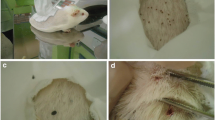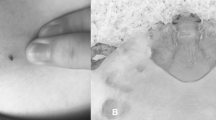Abstract
We provide evidence that tick-borne encephalitis virus and Borrelia burgdorferi s.l. are accumulated in the cement plug in the host skin within the first few hours after tick attachment. Extirpation of the tick without the cement plug, even very soon after the attachment, did not prevent the transmission by Ixodes ricinus, Ixodes persulcatus or Dermacentor reticulatus to mice. This was within 1 hour in the case of the TBE virus and after 20–22 h of attachment, in the case of Borrelia and I. persulcatus. The epidemiological significance of these findings is discussed.
Similar content being viewed by others
References
Alekseev, A.N. 1991. Ecology of tick-borne encephalitis virus: part of Ixodidae ticks males in its circulation. Ecol. Parasitol. (Leningrad, Petrozavodsk) 1: 51–62, 100.
Alekseev, A.N. 1995. Disease agents and zoonotic vectors: a system with new features. Bull. Scand. Soc. Parasitol. 5: 3–14.
Alekseev, A.N. and Chunikhin, S.P. 1990. [Experimental proof of the transsalival exchange of the tick-borne encephalitis virus.] In Sixth All-union Acarological Meeting: Theoretical and Applied Aspects of Acarology, pp. 8–9. Leningrad (in Russian).
Alekseev, A.N., Burenkova, L.A., Podboronov, V.M. and Chunikhin, S.P. 1995a. Bacteriocidal qualities of ixodid tick (Acarina: Ixodidae) salivary cement plugs and their changes under the influence of a viral tick-borne pathogen. J. Med. Entomol. 32: 578–582.
Alekseev, A.N., Podboronov, V.M. and Burenkova, L.A. 1995b. [Probable utilization of the defensive qualities of the vector saliva by the specific tick-borne pathogens]. Parazitologia 29: 154–158 (in Russian).
Alekseev, A.N., Arumova, E.A. and Vasilievs, I.S. 1995c. Borrelia burgdorferi sensu lato in the female cement plug of Ixodes persulcatus ticks (Acari, Ixodidae). Exp. Appl. Acarol. 19: 519–522.
Babenko, L.V. 1985. [Peculiarities of parasitism and life cycle.] In: Taiga tick Ixodes persulcatus Schulze (Acarina, Ixodidae). Morphology, Systematics, Ecology, Medical importance, N.A., Filippova (ed.), pp 213–219. Nauka, Leningrad (in Russian).
Balashov, Y.S. 1972. Blood sucking ticks (Ixodidae)—vectors of diseases of man and animals. Misc. Publ. Entomol. Soc. Am. 8: 161–376.
Pavlovsky, E.N. 1940. [Experimental investigation of the tick-borne encephalitis virus circulation in the tick-vector (Ixodes persulcatus) body.] Arch. Biol. Sci. 59: 111–117 (in Russian).
Binnington, K.C. and Kemp, D.H. 1980. Role of tick salivary glands in feeding and disease transmission. Adv. in Parasitol. 18: 315–339.
Binnington, K.C., Young, A. and Obenchain, F.D. 1983. Morphology of normal and Theileria parva-infected salivary glands of Rhipicephalus appendiculatus (Acari: Ixodoidea). J. Parasitol. 69: 421–424.
Chinery, W.A. 1973. The nature and origin of the ‘cement’ substance at the site of attachment and feeding of adult Haemaphysalis spinigera (Ixodidae). J. Med. Entomol. 10: 355–362.
Chunikhin, S.P., Alekseev, A.N. and Reshetnikov, I.A. 1988. [Determination of the titre of tick-borne encephalitis virus in the saliva of unfed Ixodidae.] Med. Parazitol. Parazit. Bolezni (Moscow), 3: 89–90. (in Russian).
Dzhivanyan, T.I., Lashkevich, V.A., Bannova, G.G., Sarmanova, E.S., Chuprinskaya, M.V. Vesenjak-Hirjan, J. and Vince, V. 1974. On the possible association of the DS marker of tick-borne encephalitis virus strains with species of tick vectors. Arch. Ges. Virusforsch. 45: 209–214.
Feldman-Muhsam, B., Borut, S. and Saliternik-Givant, S. 1970. Salivary secretion of the male tick during copulation. J. Insect Physiol. 16: 1945–1949.
Fivaz, B.H. and Norval, A. 1990. Immunity of the ox to the brown ear tick Rhipicephalus appendiculatus. Exp. Appl. Acarol. 8: 51–63.
Gregson, J.D. 1960. Morphology and functioning of the mouthparts of Dermacentor andersoni Stiles. Acta Trop. 17: 48–79.
Hazen-Karr, C.G., Kocan, A.A., Kocan, K.M. and Hair, J.A. 1987. The ultrastructure of sporogony in Theileria cervi (Bettencourt et al., 1907) in salivary glands of female Amblyomma americanum (L.) ticks. J. Parasitol. 73: 1182–2288.
Kaufman, W.R. 1983. The function of tick salivary glands. In current topics in vector research, 1 K.F., Harris (ed.), pp. 215–247. Praeger, New York.
Kocan, K.M. and Stiller, D. 1992. Development of Anaplasma ovis (Rickettsiales: Anaplasmataceae) in male Dermacentor andersoni (Acari: Ixodidae) transferred from infected to susceptible sheep. J. Med. Entomol. 29: 98–107.
Kocan, A.A., Kocan, K.M., Hazen-Karr, C. and Hair, J.A. 1988. Electron microscopic observations of Theileria cervi in salivary glands of male Amblyomma americanum. Proc. Helmintol. Soc. Washington 55: 55–57.
Kryuchechnikov, V.N., Gorelova, N.B. and Scherbakov, S.V. 1993. Borrelia identification and the first results of studies on Lyme disease agent isolates from Russia and neighboring countries. In Problems of tick-borne borrelioses, E.I., Korenberg (ed.), pp. 45–55. Gamaleya Institute, Moscow.
Lebet, N. and Gern, L. 1994. Histological examination of Borrelia burgdorferi infections in unfed Ixodes ricinus nymphs. Exp. Appl. Acarol. 18: 177–183.
Moorhouse, D.E. 1969. The attachment of some ixodid ticks to their natural hosts. In proceedings of the Second International Congress of Acarology, pp. 319–327. Budapest.
Moorhouse, D.E. and Tatchell, R.J. 1966. The feeding processes of the cattle-tick Boophilus microplus (Canestrini): a study in host-parasite relations. Parasitology 56: 623–632.
Moskvitina, G.G., Korenberg, E.I., Spielman, A. and Shchyogolova, T.V. 1995. [On frequencies of generalized infection in unfed adult ticks of the genus Ixodes in Russian and American foci of the borrelioses.] Parazitologia 29: 353–360. (in Russian).
Naumov, R.L. 1985. [Principles and methods of monitoring of the tick-borne encephalitis natural foci.] Thesis, Inst. Med. Parasit. Trop. Med., Moscow (in Russian).
Podboronov, V.M. and Berdijev, A. 1991. [Defence Mechanisms of the Ixodoid Ticks and Their Hosts.] Ilim, Ashgabad (in Russian).
Reed, L.J. and Muench, H. 1938. A simple method of estimation fifty per cent and point. Am. J. Hyg. 27: 493–497.
Ribeiro, J.M.C. 1987. Ixodes dammini: salivary anti-complement activity. Exp. Parasitol. 64: 347–353.
Shapiro, S.Z., Voigt, W.P. and Ellis, J.A. 1989. Acquired resistance to ixodid ticks induced by tick cement antigen. Exp. Appl. Acarol. 7: 33–41.
Spielman, A. 1992. Development of Lyme disease spirochetes in vector ticks. In First THPI, U.G. Munderloh and T.J. Kurtti (eds), pp. 47–53. St Paul, Minnesota.
Stefutkina, L.F. 1989. [Morphological and virological particularities of ixodid ticks cell and tissues infection caused by tick-borne encephalitis virus.] PhD thesis, Inst. Poliomyelit. Viral Encephal., Moscow (in Russian).
Walker, A.R. and Fletcher, J.D. 1985. Age grades and infection rates of Rhipicephalus appendiculatus Neumann (Acari: Ixodidae) to assess theileriosis challenge in the field. Bull. Entomol. Res. 75: 653–660.
Zung, J.L., Lewengrub, S., Rudzinska, M.A., Spielman, A., Telford, S.R.III and Piesman, J. 1989. Fine structural evidence for the penetration of the Lyme disease spirochete Borrelia burgdorferi through the gut and salivary tissues of Ixodes dammini. Can. J. Zool. 67: 1737–1748.
Author information
Authors and Affiliations
Rights and permissions
About this article
Cite this article
Alekseev, A.N., Burenkova, L.A., Vasilieva, I.S. et al. Preliminary studies on virus and spirochete accumulation in the cement plug of ixodid ticks. Exp Appl Acarol 20, 713–723 (1996). https://doi.org/10.1007/BF00051556
Received:
Revised:
Accepted:
Issue Date:
DOI: https://doi.org/10.1007/BF00051556




